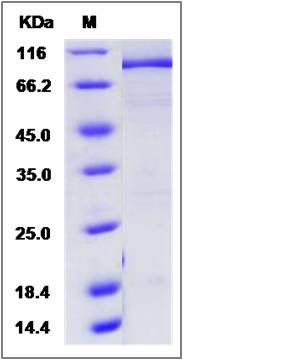Human KDM1 / LSD1 Protein (His & GST Tag)
AOF2,BHC110,KDM1,LSD1
- 100ug (NPP2289) Please inquiry
| Catalog Number | P13721-H20B1 |
|---|---|
| Organism Species | Human |
| Host | Baculovirus-Insect Cells |
| Synonyms | AOF2,BHC110,KDM1,LSD1 |
| Molecular Weight | The recombinant human KDM1 /GST chimera consists of 917 amino acids and has a calculated molecular mass of 103.3 kDa. The recombinant protein migrates as an approximately 93 kDa band in SDS-PAGE under reducing conditions. |
| predicted N | Met |
| SDS-PAGE |  |
| Purity | > 90 % as determined by SDS-PAGE |
| Protein Construction | A DNA sequence encoding the human KDM1 (O60341-1) (Ser172-Met852) was fused with the N-terminal poly histidine-tagged GST tag at the N-terminus. |
| Bio-activity | |
| Research Area | Epigenetics |Histone Modifying Enzymes |Methylation and Demethylation |Histone demethylation |
| Formulation | Lyophilized from sterile 20mM Tris, 500mM NaCl, 2mM DTT, pH 8.0, 10% gly 1. Normally 5 % - 8 % trehalose, mannitol and 0.01% Tween80 are added as protectants before lyophilization. Specific concentrations are included in the hardcopy of COA. |
| Background | LSD1 belongs to the flavin monoamine oxidase family. It contains 1 SWIRM domain and is a component of a RCOR/GFI/LSD1/HDAC complex. LSD1 interacts directly with GFI1 and GFI1B. LSD1 speficially removes histone H3K4me2 to H3K4me1 or H3K4me0 through a FAD-dependent oxidative reaction. When forming a complex with androgen receptor (and possibly other nuclear hormone receptors), LSD1 changes its substrates to H3K9me2. Thus LSD1 is considered to act as a coactivator or a corepressor. It may play a role in the repression of neuronal genes. Alone, LSD1 is unable to demethylate H3 'Lys-4' on nucleosomes and requires the presence of RCOR1/CoREST to achieve such activity. |
| Reference |
